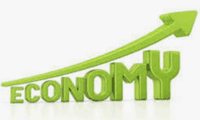| |
|
| |
|
 |
Supply
Chain by the Numbers |
| |
|
| |
- Feb. 3, 2022
|
| |
|
| |
|
| |
|
| |
NRF Says US Economy to Stay Strong in 2022; US PMI for January also Shows Strength Again; Wall Street Betting on Huge ESG Reporting Growth; New Strategy Drives Great Results at UPS |
| |
|
| |
| |
| |
| |
3-4% |

|
| That is the forecast for US real economic growth from Jack Kleinhenz, chief economist of the National Retail Federation, in a press release this week. That is decent growth for this year, but well down from growth of 5.7% in 2021, according to recent first estimate from the Commerce Dept. 2021 also was the first year with US GDP growth of 3% or more since 2005, before which it was commonplace. If Kleinhenz is correct, it will happen again in 2022. His forecast is generally consistent with the recent prediction of 4.0% growth from the International Monetary Fund, as we reported last week. “Despite ongoing challenges, we are clearly still in an expansion phase,” Kleinhenz said in the release, even with the Federal Reserve is expected to raise interest rates soon to slow the economy and inflation. |
|
|
| |
| |
|
|
|
| That was the level of the US Purchasing Managers Index for January from the Institute for Supply Management, as released in the monthly report this week. That was a decrease of 1.2 percentage points from the seasonally adjusted December reading of 58.8, but was still well above the key 50 mark the separates US manufacturing expansion. It also indicates expansion in the overall economy for the 20th month in a row after the last contraction in April and May of 2020. The 57.6 level in January is actually the lowest score in the past 12 months, with a steady string of strong scores, and 8 of the last 12 coming in over 60. The New Orders Index registered 57.9, down 3.1 percentage points compared to the seasonally adjusted December reading of 61, but again well above the 50 mark, in a good sign for future manufacturing activity. |
| |
| |
|
|
| |
| |
15% |
|
That was the strong level of revenue growth at UPS in 2021, according to company’s Q4 earnings release this week. But profits were even stronger, rising to $12.9 billion compared with $1.4 billion in 2020. Some are citing relatively new CEO Carol Tome’s strategy of prioritizing more profitable deliveries and contracts over boosting volumes as key to the profit surge. As evidence, UPS’ average daily shipping volume actually fell 0.6% versus 2020 – but revenue rose 11.5%, while profits were $3.09 billion, versus a loss in 202o. The 2020 loss was the result of $5.6 billion in charges related to the company’s pension plan and other non-operating issues. UPS US also saw a 10.5% increase in revenue per piece in Q4. Interestingly, Amazon’ share of UPS’s total domestic revenue fell to 11.7% in Q4, versus 13.3% a year ago, as Amazon dramatically expands its own parcel network. |
| |
| |
| |
| |
| |
|
|
|
| |
 |
 |
| |
 |
![]() |
 |
|
| |
 |
Feedback |
|
|
|
![]()
|
No Feedback on this article yet.
|
|
![]() |
|
|
|
![]() |
 |
![]() |
 |
|
| |